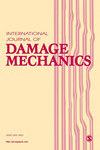Numerical analysis of size effect on the deformation behavior and damage evolution mechanism of segmental tunnel lining rings
IF 4
2区 工程技术
Q2 MATERIALS SCIENCE, MULTIDISCIPLINARY
引用次数: 6
Abstract
This article investigates the size effect of segmental tunnel linings on the deformation behavior and the damage evolution mechanism using the Finite Element Method (FEM). A series of models with different diameters are established under the same loading condition to control the variable. The bolts and the rebar apply the elastic-plastic model. The Concrete Damage Plasticity model has been considered for the concrete lining. The vertical convergence deformation, internal force of these models, and damage to the segment body are selected for comparison. The number and location of the yielded bolts are explored for the analysis of the overall structure stiffness and damage evolution mechanism. In terms of plastic hinge theory, an extended discussion is carried out to explain the differences in damage evolution mechanisms in different-sized linings. The results show the large-diameter lining rings have a relatively greater increasing rate of convergence deformation. Furthermore, fewer plastic hinges emerged in large-scale lining rings before the structures reached their ultimate strength. According to the experimental results, we can know that the failure of large-diameter has the characteristic of more brittle damage than that of small-diameter one and these large-size structures are prone to become unstable geometry.尺寸效应对管片隧道衬砌环变形行为及损伤演化机制的数值分析
本文采用有限元法研究了管片隧道衬砌尺寸对其变形行为的影响及损伤演化机制。在相同的加载条件下,建立了一系列不同直径的模型来控制变量。螺栓和钢筋采用弹塑性模型。考虑了混凝土衬砌的损伤塑性模型。选取各模型的竖向收敛变形、内力和管片体损伤进行比较。探讨了屈服螺栓的数量和位置,分析了整体结构的刚度和损伤演化机制。从塑性铰理论出发,进一步探讨了不同尺寸衬砌损伤演化机制的差异。结果表明:大直径衬环具有较大的收敛变形增加速率;此外,在结构达到极限强度之前,大型衬砌环中出现的塑性铰较少。由实验结果可知,大直径破坏比小直径破坏具有脆性破坏的特点,这些大尺寸结构容易成为不稳定的几何结构。
本文章由计算机程序翻译,如有差异,请以英文原文为准。
求助全文
约1分钟内获得全文
求助全文
来源期刊

International Journal of Damage Mechanics
工程技术-材料科学:综合
CiteScore
8.70
自引率
26.20%
发文量
48
审稿时长
5.4 months
期刊介绍:
Featuring original, peer-reviewed papers by leading specialists from around the world, the International Journal of Damage Mechanics covers new developments in the science and engineering of fracture and damage mechanics.
Devoted to the prompt publication of original papers reporting the results of experimental or theoretical work on any aspect of research in the mechanics of fracture and damage assessment, the journal provides an effective mechanism to disseminate information not only within the research community but also between the reseach laboratory and industrial design department.
The journal also promotes and contributes to development of the concept of damage mechanics. This journal is a member of the Committee on Publication Ethics (COPE).
 求助内容:
求助内容: 应助结果提醒方式:
应助结果提醒方式:


